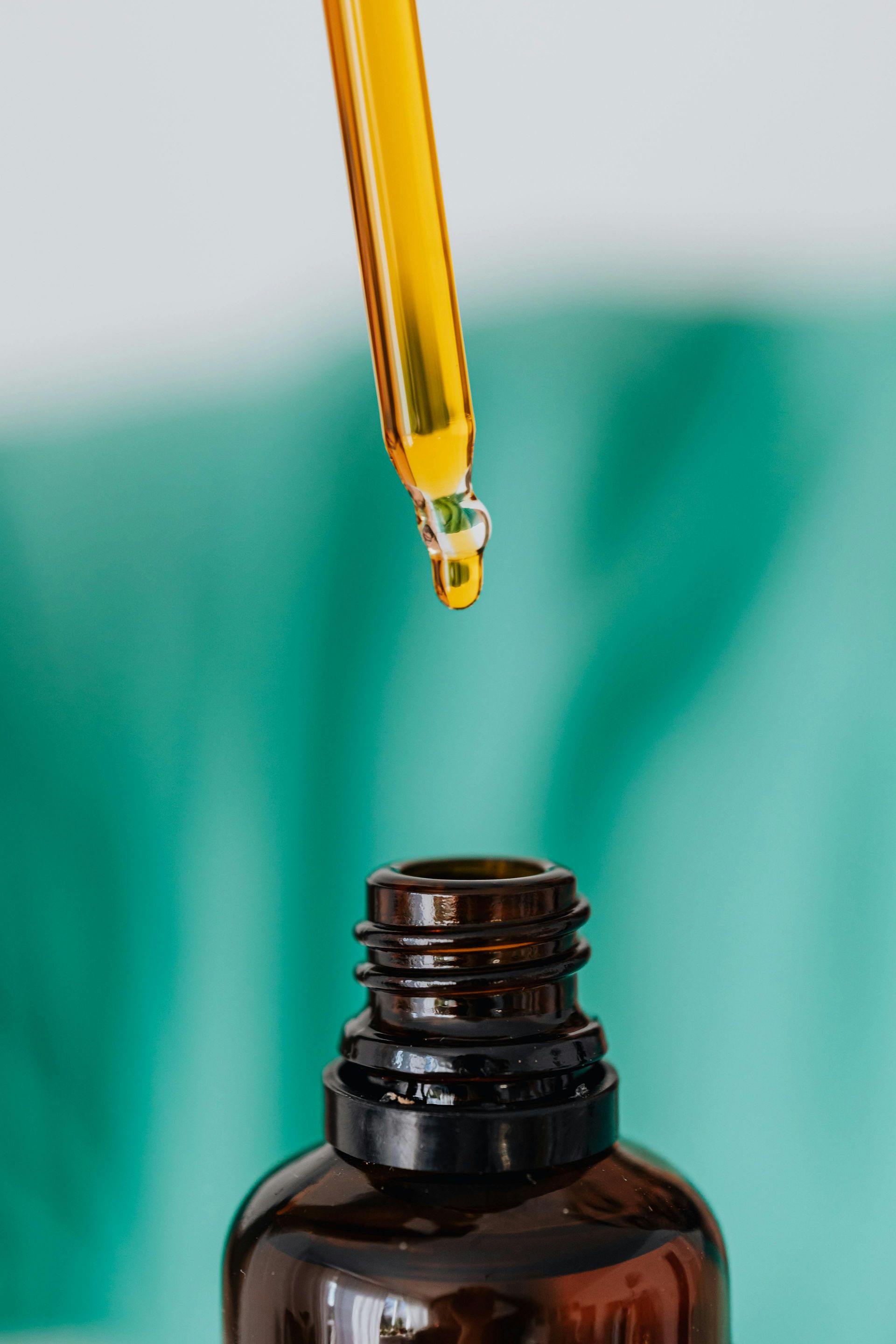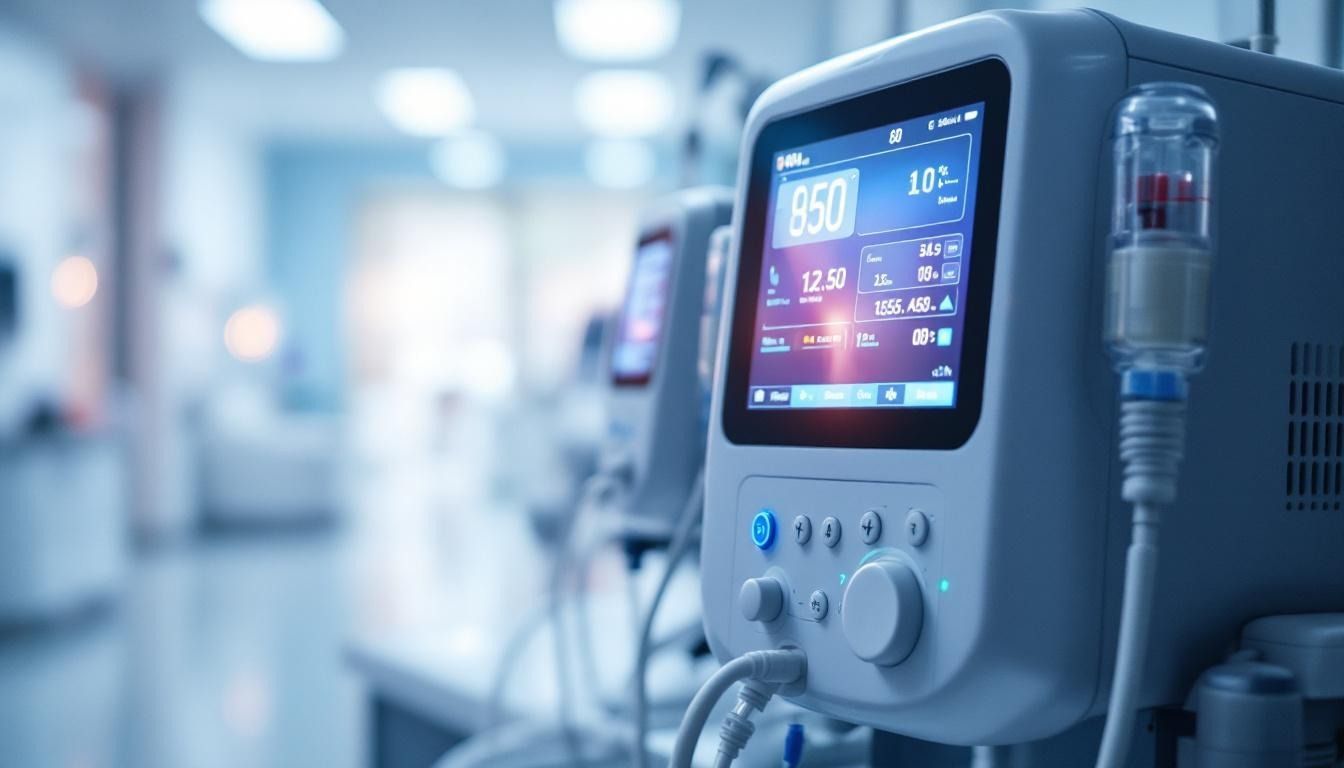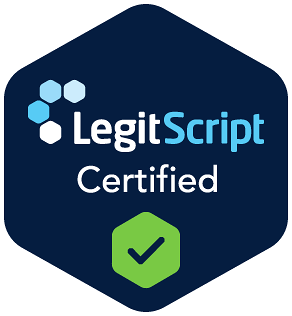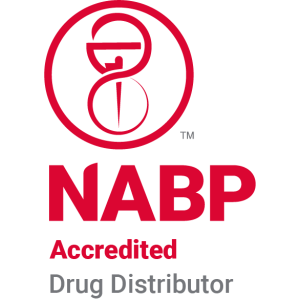Home-based infusion for hydration
Understanding Home-Based Infusion Therapy for Hydration
Home-based infusion therapy for hydration is transforming how patients with dehydration and related conditions receive essential fluids. By allowing treatment in the comfort of their homes, patients benefit from personalized care, convenience, and reduced hospital visits. This article explores the nuances of home hydration infusion, covering procedures, conditions treated, safety standards, and access points to better inform patients and healthcare providers alike.
What Home-Based Infusion Therapy for Hydration Involves
What does home-based infusion therapy for hydration involve?
Home-based infusion therapy for hydration is a process where fluids, such as saline or electrolyte solutions, are delivered directly into a patient’s bloodstream through a vein. This method provides rapid and effective rehydration, bypassing the digestive system for better absorption. It is particularly useful for patients experiencing dehydration due to illnesses, gastrointestinal disorders, or recovery from medical procedures.
The therapy is performed in the comfort of the patient's home, offering convenience and a sense of normalcy. It requires specialized equipment, including infusion pumps that control the flow rate of fluids, tubing, and vascular access devices such as catheters or ports. These devices provide a secure and sterile pathway for fluid delivery and are selected based on the patient's medical needs and treatment duration.
Trained infusion nurses oversee the entire process, ensuring that the administration is safe and effective. They assess the infusion site, monitor for any signs of complications, and adjust the infusion settings as needed. Patient and caregiver training is a vital part of the process. Nurses educate them on how to manage the infusion equipment, perform dressing changes, recognize warning signs of issues like infection or infiltration, and respond appropriately.
Coordination among various healthcare entities is essential for successful home infusion therapy. Physicians prescribe the treatment, which is then coordinated with licensed and accredited pharmacies that prepare the sterile medications. Home health agencies or visiting nurses deliver and set up the infusion equipment, providing ongoing support and monitoring.
This collaborative approach ensures that patients receive high-quality, continuous care outside of hospitals or clinics, reducing hospital visits and improving overall outcomes. Home infusion therapy for hydration is a safe, effective, and patient-centered option tailored to individual needs and circumstances.
Conditions Treated with Home Hydration Infusion

Which conditions can be treated with home infusion therapy for hydration?
Home infusion therapy for hydration is an essential treatment modality for various medical conditions where maintaining the body’s fluid balance is critical. It is especially effective for managing dehydration resulting from illnesses, surgeries, or other health issues that impair normal fluid intake.
This therapy is commonly employed in patients experiencing dehydration due to gastrointestinal diseases such as severe vomiting or diarrhea. These conditions disrupt normal fluid absorption and retention, making IV hydration necessary. When patients are unable to keep fluids down or require faster rehydration, home infusion provides a safe, convenient alternative outside the hospital setting.
In addition to gastrointestinal issues, hydration infusion is crucial in managing dehydration from severe infections, such as urinary tract infections or pneumonia, which can lead to fluid loss. Post-surgical patients, particularly those who have difficulty oral intake or are at risk of fluid imbalance, benefit from home hydration therapy to ensure proper recovery.
Chronic illnesses that involve fluid imbalance, such as end-stage heart failure, often require careful management of fluid intake. Home infusion services help these patients avoid hospital visits while maintaining optimal hydration, thus improving quality of life.
Moreover, immune disorders and certain cardiac conditions that demand precise fluid regulation also make use of hydration infusion. For instance, individuals with autoimmune diseases or those undergoing treatments like immunoglobulin therapy may need supplemental fluids administered intravenously at home.
Overall, home hydration infusion supports patient recovery across a wide range of health conditions. It provides an effective, patient-centered solution to prevent complications associated with dehydration, reduce hospital stays, and promote comfort and independence.
| Condition Type | Examples | Benefits |
|---|---|---|
| Gastrointestinal illnesses | Vomiting, diarrhea, Crohn’s disease | Rapid rehydration, comfort, reduction in hospital visits |
| Post-surgical care | Abdominal, orthopedic surgeries | Maintains hydration, supports healing |
| Chronic illness management | Heart failure, autoimmune disorders | Balances fluids, prevents dehydration-related complications |
| Infectious diseases | Pneumonia, urinary tract infections | Restores fluid loss, supports immune function |
| Cardiac and immune disorders | Congestive heart failure, immunodeficiency | Ensures appropriate hydration without overloading organs |
This broad range of conditions highlights the versatility and importance of home infusion therapy in managing dehydration and supporting overall health.
Benefits and Advantages of Home Hydration Infusion
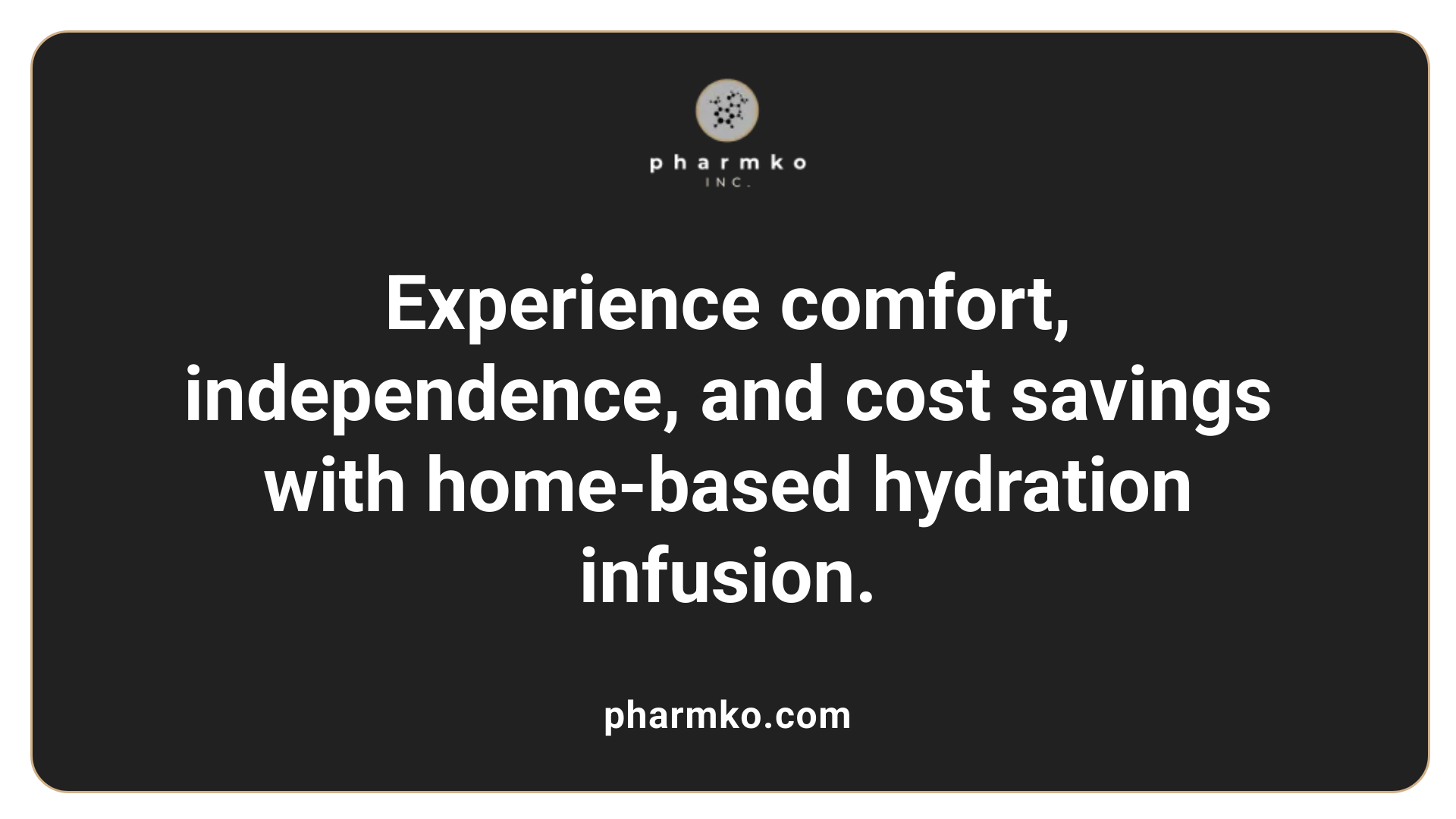
What are the benefits of home infusion therapy for hydration?
Home infusion therapy for hydration brings a range of advantages that enhance patient comfort and well-being. This treatment allows individuals to receive essential fluids such as saline or Lactated Ringer’s solution directly in their own homes, eliminating the need for frequent hospital visits or staying in clinics. Patients can maintain their daily routines, continue working, and enjoy time with family and friends without the disruption of travel or hospital stays.
A significant benefit is the personalized care provided by trained infusion nurses. These professionals not only administer the hydration but also offer education, monitor for potential complications, and adjust treatments as needed. This close oversight ensures safety and maximizes the effectiveness of therapy.
Reducing hospital visits minimizes exposure to healthcare-associated infections, which is especially crucial for immunocompromised patients. Home hydration therapy also plays a role in lowering healthcare costs by decreasing inpatient stays, emergency visits, and resource utilization.
Patients often report a better quality of life because they experience less stress, more independence, and freedom from the constraints of traditional treatment settings. Comfort, convenience, and tailored healthcare support contribute to improved health outcomes.
Overall, home hydration infusion is a safe, efficient, and patient-centric solution that supports long-term health and well-being, making it an increasingly preferred option among healthcare providers and patients alike.
How Home Infusion for Hydration Is Administered and Managed
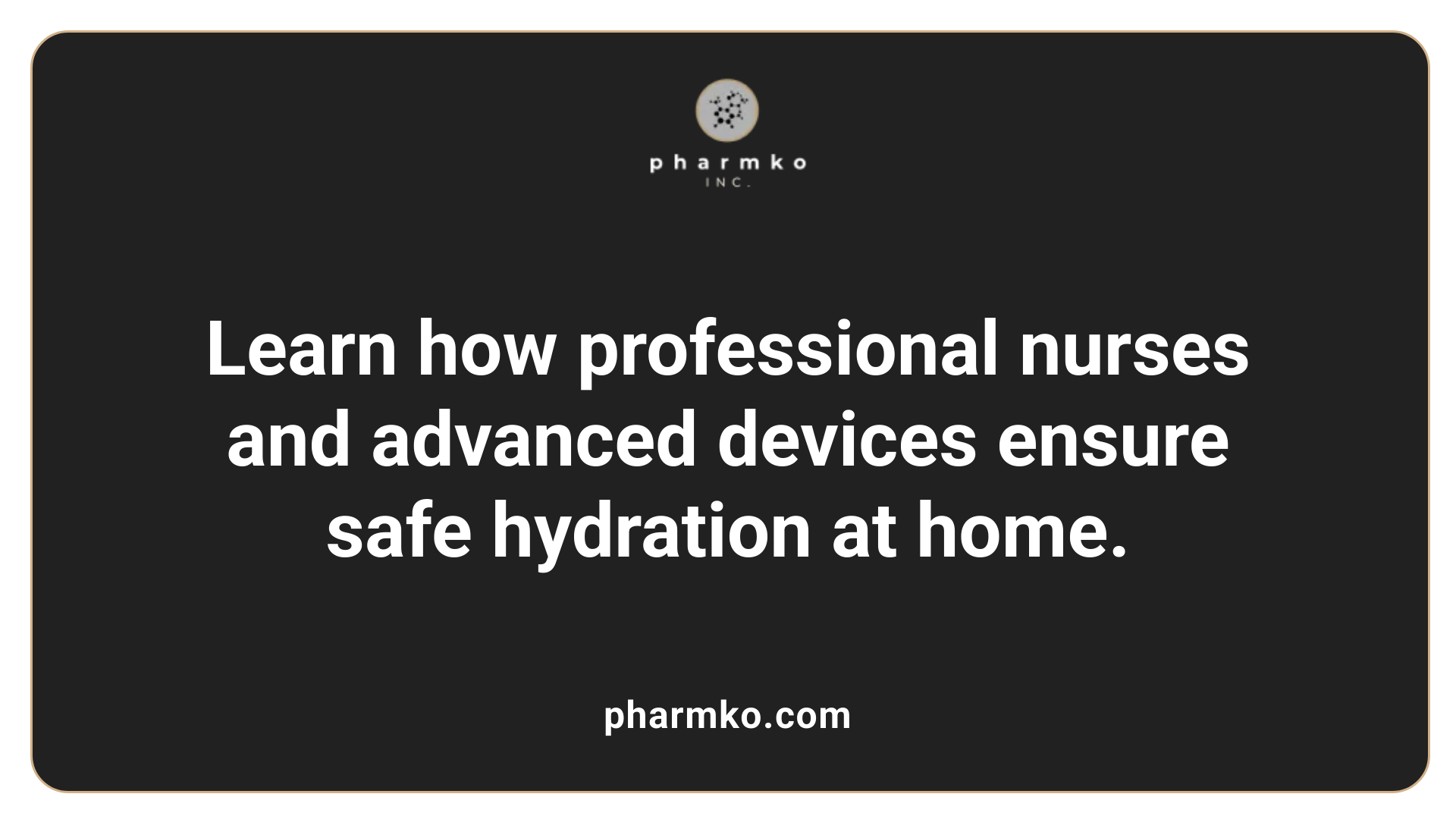
How is home infusion therapy for hydration administered and managed?
Home infusion therapy for hydration is a vital service that allows patients to receive fluids and electrolytes safely in the comfort of their homes. The process primarily involves delivering fluids via intravenous (IV) or subcutaneous routes, utilizing a range of infusion devices tailored to individual needs. These devices include IV push systems, elastomeric infusion pumps, gravity infusion setups, ambulatory pumps, or stationary pumps. The choice of device depends on factors such as medication stability, required dosing, duration of therapy, cost considerations, and patient preferences.
Before beginning therapy, specially trained infusion nurses assess the patient and educate them and their caregivers about the procedure. This training includes instructions on how to operate the infusion device, recognize potential side effects, care for vascular access sites, and manage any complications. Nurses also evaluate the home environment to ensure it is suitable for safe infusion therapy, checking for cleanliness, accessibility, and proper storage of supplies.
The infusion is typically administered through vascular access devices such as peripherally inserted central catheters (PICCs), ports, or midlines. The selection of the access device depends on the duration of therapy and medication type. High-quality sterile techniques are essential to minimize infection risks.
Throughout the treatment, healthcare providers maintain close monitoring for adverse reactions like allergic responses or site infections. They also oversee the proper functioning of infusion equipment, making adjustments as necessary. Many programs incorporate remote monitoring technologies that transmit data on therapy progress and patient status to healthcare teams.
Coordination among different healthcare entities is crucial. Physicians prescribe the hydration therapy after assessing the patient’s needs, the pharmacy prepares and ships the sterile medications and supplies, and home infusion nurses ensure that the therapy is delivered safely and effectively. Ongoing communication among these providers helps tailor the treatment plan, troubleshoot issues, and optimize outcomes.
In essence, home infusion for hydration combines advanced medical devices, professional oversight, and patient education to deliver safe, effective, and personalized care outside traditional clinical settings. This approach not only enhances patient comfort and convenience but also reduces healthcare costs and minimizes hospital stays.
| Route of Administration | Devices Used | Key Considerations |
|---|---|---|
| IV infusion | Pumps, gravity infusion | Regular site monitoring, sterile technique |
| Subcutaneous infusion | Elastomeric devices | Comfort, ease of use, portability |
Choosing the right infusion route, device, and management plan is essential to ensure safety and efficacy in hydration therapy in the home environment.
Infusion Options and Treatment Packages for Hydration
What types of infusion options and treatment packages are available for hydration?
Hydration therapy at home typically involves the use of various fluids to restore or maintain the body's fluid and electrolyte balance. Common fluids include saline solutions like 0.9% sodium chloride (normal saline) and lactated Ringer's solution, each chosen based on the patient’s specific needs. In addition to standard saline, electrolyte solutions can be customized with vitamins, minerals, and electrolytes to address individual health requirements.
These fluids are administered via different infusion methods, primarily intravenous (IV) infusions, but sometimes through subcutaneous routes in certain cases. The choice depends on the severity of dehydration, the need for rapid rehydration, and patient preferences. Infusion therapy providers, such as Mount Sinai and Johns Hopkins, offer a variety of treatment packages designed to cater to these needs.
How are infusion options tailored for individual patients?
Personalized treatment is a hallmark of effective hydration therapy. Providers assess each patient's health status, dehydration level, and underlying conditions to customize fluid mixtures. For example, a patient with electrolyte imbalance may receive fluids enriched with potassium or magnesium, while someone recovering from illness might get a balanced electrolyte solution.
The therapy setup includes not only the fluids but also the equipment needed for safe administration, such as infusion pumps, tubing, and vascular access devices like PICCs or ports. This customization ensures that therapy is both safe and efficient, minimizing complications and maximizing comfort.
What support services are part of hydration treatment packages?
Comprehensive hydration therapy packages go beyond just providing fluids. They include essential support services like professional nursing care, patient and caregiver education, and continuous monitoring. Trained infusion nurses provide initial assessments, device placement, and ongoing supervision during treatments, ensuring safety.
Education sessions help patients and caregivers understand how to manage infusion devices, recognize signs of adverse reactions, and maintain proper hygiene. This equips families to support routine therapies confidently at home.
Remote monitoring services are also integrated into many programs. These can involve regular telephone or digital check-ins to evaluate the patient’s response, adjust treatment protocols, and promptly address any issues.
How does care coordination enhance hydration therapy?
Coordination among healthcare providers is crucial for successful hydration treatment. Systems are in place to ensure communication between physicians, pharmacists, infusion nurses, and home health agencies. This integrated approach helps tailor therapy plans, manage medications, and respond swiftly to any health changes.
Providers often offer all-inclusive care packages, which streamline the process from prescription to treatment and follow-up. These packages include medication preparation in licensed pharmacies, timely delivery, patient education, and clinical follow-up.
Overview of infusion options and comprehensive care packages
| Infusion Type | Fluids Used | Delivery Method | Support Services | Typical Conditions Treated |
|---|---|---|---|---|
| Standard hydration | Saline, Lactated Ringer’s | IV infusion, subcutaneous | Nursing, education, remote monitoring | Dehydration, exhaustion, post-operative recovery |
| Customized electrolyte | Potassium, magnesium, multivitamins | IV or syringe pump | Device management, patient training | Electrolyte imbalance, chronic dehydration |
| Nutritional hydration | Total parenteral nutrition (TPN) | Continuous infusion | Monitoring, nutritional assessment | Malnutrition, gastrointestinal disorders |
| Specialty hydration | Vitamins, minerals, antioxidants | As ordered | Ongoing clinical evaluation | Immune support, recovery from illness |
By offering tailored infusion options combined with professional care and support services, providers aim to enhance patient comfort, safety, and overall treatment outcomes. These comprehensive packages make hydration therapy accessible, manageable, and less disruptive to daily life, whether in the comfort of home or in outpatient settings.
Safety Standards, Eligibility, and Access to Home Infusion Therapy

What safety standards and considerations are there for home infusion therapy?
Safety is a fundamental aspect of home infusion therapy. Strict adherence to sterilization, aseptic techniques, and infection control practices are mandated by regulatory bodies like the U.S. Pharmacopeia (USP) Chapter 797, which sets standards for sterile compounding and medication safety.
Accredited infusion providers, often certified by organizations such as The Joint Commission, are required to maintain high safety and quality standards. This includes developing personalized care plans, conducting regular reviews, and ensuring staff competency through continuous training and assessments.
Pharmacies providing medications comply with federal and state guidelines for proper medication management, including secure storage, accurate documentation, and proper labeling to prevent errors.
Training of patients and caregivers is crucial. Qualified nurses educate on safe administration techniques, recognizing side effects, and managing equipment. They also establish 24/7 support contact, providing immediate assistance if needed.
Quality improvement programs and rigorous documentation practices help monitor outcomes and prevent adverse events. Proper device sterilization, secure vascular access management, and ongoing clinical oversight are vital to reducing risks such as infection or device complications.
Overall, safety protocols in home infusion therapy aim to protect patients while maintaining effective treatment, supported by accreditation standards, staff qualifications, and robust supervision mechanisms.
What are the eligibility criteria for receiving home infusion therapy for hydration?
Eligibility for hydration therapy via home infusion depends on multiple factors. Primarily, Medicare Part B coverage plays a significant role, requiring that the patient’s condition warrants intravenous fluid supplementation.
The patient must have a healthcare provider—such as a physician, nurse practitioner, or physician assistant—who certifies that home infusion for hydration is medically necessary. This involves developing a detailed, physician-approved care plan that specifies the type, volume, and frequency of fluids needed.
Before initiating therapy, the provider conducts a thorough assessment of the patient’s home environment to ensure safety. This includes evaluating the availability of a clean, safe space for therapy, and the caregiver’s ability to assist if needed.
The ordering clinician must sign a formal prescription, which serves as documentation for the home infusion provider. The selected provider must be Medicare-approved and adhere to accreditation standards, ensuring quality and safety in delivering services.
Equipment and supplies must be appropriate and certified, including infusion pumps and vascular access devices like peripheral or central catheters. Training for patients and caregivers is essential to promote safe self-administration when applicable.
Regular review and monitoring are necessary to adapt the care plan as the patient’s condition evolves. These measures ensure only suitable candidates receive home infusion therapy for hydration, maximizing safety and effectiveness.
Access points including pharmacies and healthcare organizations
Patients can access home infusion therapy through licensed and accredited pharmacies that prepare and dispense medications under strict sterile conditions. These pharmacies coordinate closely with healthcare providers to ensure timely delivery of tailored treatment regimens.
Various healthcare organizations, including hospitals, outpatient clinics, and specialized infusion companies, provide home infusion services. These entities typically employ trained infusion nurses who assist with setup, patient education, and ongoing management.
Reputable pharmacies and providers are often part of larger health systems or have affiliations with national organizations, ensuring standardization and high quality of care. They maintain accreditation from agencies like The Joint Commission, which verifies adherence to safety, quality, and operational standards.
Patients also access services through dedicated home health agencies and disease-specific programs, which coordinate multidisciplinary care tailored to individual needs.
Regulatory and policy guidelines
The 21st Century Cures Act, effective from January 1, 2021, established a Medicare benefit specifically for home infusion therapy. It covers professional nursing, training, education, remote monitoring, and other related services.
Coverage eligibility depends on a physician’s order, the necessity of the therapy, and the provider’s compliance with licensing and accreditation standards. The Act emphasizes quality assurance, patient safety, and integration of care across settings.
Medicare's coverage, however, is primarily limited to infusion drugs under Part D, with partial coverage for associated services under Parts A and B. Most private insurers, Medicaid, and TRICARE reimburse for home infusion services, recognizing their cost-effectiveness and patient-centered benefits.
Guidelines regulate the selection of vascular access devices, infusion methods, and nursing oversight. Procedure codes such as 99601 and 99602 are used for billing and reimbursement purposes.
Overall, policies support a structured approach to ensuring safe, accessible, and effective home infusion therapy for eligible patients, with an emphasis on quality, safety, and coordinated care.
The Future of Home Hydration Therapy
As healthcare continues to evolve, home-based infusion for hydration represents a vital component of patient-centered care, offering effective, safe, and convenient treatment options outside traditional hospital settings. With ongoing advancements in technology, safety protocols, and policy support, the accessibility and scope of these services are expected to expand, further improving health outcomes and patient satisfaction.
References
- Mount Sinai Home Infusion
- Home Infusion Therapy/Home IVIG Services
- What is home infusion? | IV therapy | NHIA
- Home Infusion Therapy Services in New Jersey
- A Primer on Home Infusion Administration Methods - PMC
- Infusion Services | Johns Hopkins Care at Home
- Navigating IV Therapy at Home
- In Home Infusion
- Home Infusion
- Infusion therapy: A model for safe practice in the home setting



